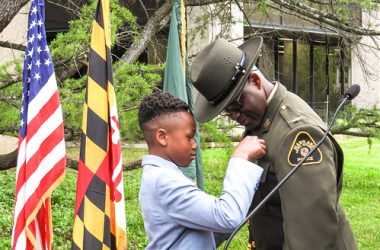by Kate Evans
The range of the invasive spotted lanternfly (Lycorma delicatula) continues to increase as it threatens fruit trees, hardwood trees and crops in a number of eastern states, including Pennsylvania, Maryland, West Virginia and Virginia. The insect was first found in Pennsylvania in 2014.
The spotted lanternfly was first sighted in Berkeley County on October 30, 2019, in Mineral County on September 28, 2020 and in Jefferson County on May 21, 2021. It was first reported in Morgan County in late September, 2021.
Washington and Frederick Counties were added to the Maryland quarantine list for spotted lanternfly back in January, 2022.
Agriculture officials have said that if the insect is allowed to spread that it could severely impact the country’s grape orchards, fruit trees, plant nurseries, ornamental trees and forest industries.
Spotted lanternfly populations are currently found in 11 states including West Virginia, Maryland, Pennsylvania, Virginia, Ohio, Connecticut, Delaware, Massachusetts, Indiana, New Jersey and New York. Winchester and northern Frederick County, Virginia have large populations of the insect.
All states are requesting the public’s help in watching for the insect and stopping its spread.
At-risk trees and plants
Spotted lanternfly feeds on a wide variety of over 70 plants, crops and trees. Those at risk include almonds, apples, apricots, basil, blueberries, birch, cherries, cucumber, grapes, hickories, hops, horseradish, maples, nectarines, oaks, peaches, pine trees, plum, poplar, sycamores, walnut and willow trees. The adult and juvenile lanternflies which are called nymphs prefer to feed on the tree of heaven. (Ailanthus altissima)
The insect sucks the sap out of stems and branches, weakening the plants, causing stunted growth and reduced yield, even killing the plants. Their feeding also leaves behind a sticky residue called honeydew that encourages a black, sooty mold to grow that can also cause plant damage.
Signs of an infestation are plants that ooze or weep and that have a fermented odor, a build-up of stick fluid or honeydew on or on the ground underneath infected plants and sooty mold.
According to information from the West Virginia Department of Agriculture, the trees that the spotted lanternfly feeds on develop weeping wounds with the areas of sap attracting other insects like wasps, hornets and ants. The spotted lanternfly feeding damage could kill plants and trees especially if combined with stressors such as drought, disease and other pests.

Native to Asia
Spotted lanternflies are native to China, India and Vietnam so the insects probably came to the United States inside a package shipment from Asia. Spotted lanternflies are notorious plant-hoppers and hitchhikers.
Spotted lanternflies congregate in the fall on tree trunks in groups of 15 to 20 to lay their egg masses. Newer egg masses will have a gray putty-like covering on top of them. Older egg masses look like four to seven columns of 30 to 50 brown seed-like clusters.
Eggs hatch in the spring and early summer.
Stop its spread
Home owners should check for egg masses on tree trunks, stone surfaces, playground equipment, brick, vehicles, trailers, outdoor equipment, patio and lawn furniture and other smooth surfaces.
Residents should scrape the egg masses from the surface, removing all the eggs from underneath the coating and double bag and trash, smash them, then burn or submerge the eggs in a plastic bag of alcohol or hand sanitizer. Use an old credit card, putty knife, screwdriver or similar item for scraping.
Also look for the juvenile nymph and adult stages of the spotted lanternfly and squish them. Adult and juvenile spotted lanternflies can often be seen gathered in large groups on host plants and trees at dusk. If you find signs of the spotted lanternfly on your property, be sure to notify your county extension office or your state Department of Agriculture.
Residents are advised to kill all adult spotted lanternflies that they can. The adults have pinkish-tan wings with spots and yellow abdomens with black stripes.
“Every insect killed is one less that can reproduce,” they noted.
If you’re in a quarantine area, look before you leave. Inspect vehicles, trailers and even your own clothing to stop the spread of the insect.
Where to report sightings
In West Virginia, report spotted lanternfly sightings to the West Virginia Department of Agriculture at 304-558-2212 or e-mail photos of suspected spotted lanternflies or infestations to [email protected].
For Maryland, if you see any egg masses or insects that look like the spotted lanternfly, contact the Maryland Department of Agriculture at (410) 841-5920 or report it on their website at https://mda.maryland.gov/ plants-pests/pages/spotted-lantern-fly.aspx.
For Pennsylvania, call the Penn State Extension Office hotline at 1-888-422-3359 (1-888-4BAD-FLY) or report a sighting on the Pennsylvania Department of Agriculture website at https://www.agriculture.pa.gov/Plants_Land_Water/PlantIndustry/Entomology/spotted_lanternfly/Pages/default.aspx.
For Virginia, report a spotted lanternfly to this link: https://vce.az1.qualtrics.com/jfe/form/SV_0fdsQXRg8TO8uzk. In Winchester and Frederick County, the spotted lanternfly is well established, and there is no need to report.



